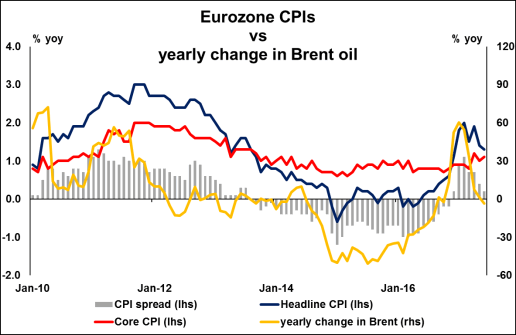Next week’s market movers
- In Eurozone, the ECB policy gathering will probably shed some light on whether the Bank is set to announce QE tapering soon, perhaps as early as September.
- In Japan, the BoJ is unlikely to take any action or make any notable changes to its bias with inflation still hovering near 0%.
- We also get key economic data from China, New Zealand, Australia, the UK, and Canada.
On Monday, during the Asian morning, we get China’s GDP data for Q2. The forecast is for economic growth to have slowed slightly in yearly terms, something supported by the fact that both retail sales and industrial production slowed somewhat in April, and did not manage to recover in May. We also get the nation’s industrial production, fixed asset investment and retail sales, all for June. Retail sales and fixed asset investment are both expected to have slowed slightly, further enhancing the case for a slowdown in GDP. Meanwhile, industrial production is forecast to have risen at the same pace as previously.

On Tuesday, the RBA releases the minutes from its latest policy gathering, where policymakers decided to leave interest rates unchanged. In the statement accompanying the decision, the Bank stated that indicators of the labor market remain mixed. Policymakers acknowledged that employment growth has been stronger over recent months, but they expressed concerns with regards to wage growth. They specifically noted that wage growth remains low, and that this is likely to continue for a while yet. As such, will look through the minutes for more details on how long the Bank expects this weakness to persist and how it can affect its future path of policy.

On Tuesday, during the Asian day, we get New Zealand’s CPI data for Q2 and the forecast is for the nation’s inflation rate to have declined to +1.9% yoy, from +2.2% yoy previously. The case for a slowdown is supported by the ANZ inflation gauge, which came in at +2.1% yoy in June. A decline in the nation’s CPI rate could amplify our view that the RBNZ is likely to remain on hold in the foreseeable future, possibly throughout this year.

In the UK, the CPI prints for June will be in focus. The forecast is for the headline rate to have ticked down, but to still remain notably above 2%, while the core rate is expected to have remained unchanged. We see the risks surrounding the core forecast as skewed to the downside, considering that the nation’s services PMI for June indicated that the rise in average prices was the slowest since July 2016. A potential pullback in these rates would probably ease some of the pressure on the BoE to raise rates in order to curb overshooting inflation.

On Wednesday, we have a relatively quiet day, with no major events or indicators due to be released.
On Thursday, during the Asian morning, the BoJ gathers to decide on monetary policy. At its latest meeting, the Bank kept its QQE with yield-curve control framework untouched, providing no signals regarding a QE-exit plan as had been suggested by some media reports back then. With inflation still hovering near 0%, we expect the Bank to provide little changes at this meeting, if any. Even if policymakers communicate a future exit from monetary stimulus, we think that they will do so without giving the impression that this is on the agenda any time soon. Our view is enhanced by the latest comments from BoJ Governor Kuroda, who noted that the Bank will maintain QQE with yield curve control for as long as needed to achieve 2% inflation in a stable manner.

From Australia, we get employment data for June, though no forecast is available yet. Our own view is that the nation enjoyed another month of stellar employment gains. We base that on the ANZ jobs advertisements indicator, which showed that jobs ads accelerated notably in June. Nevertheless, given that the RBA already acknowledged the progress in employment growth, but remained concerned on the wages front, the indicators that will probably play the biggest role with regards to the Bank’s future policy are the wage price index for Q2 and average weekly earnings for H1, released on the 16th and 17th of August respectively, after the RBA’s next gathering. Even though the NAB business survey for June showed that wage growth accelerated in Q2, we don’t expect any major changes in the Bank’s language when it meets next. Officials may prefer to wait for concrete signs that wages are indeed picking up.

As for the rest of the day, the main event will be the ECB policy decision. Given that no change in policy is expected, market focus will probably be on whether the Bank will remove any more dovish aspects from its forward guidance and specifically, the bias that the QE program can be expanded in terms of size if needed. For background, we should note that the ECB has removed dovish aspects from its guidance at both the March and the June meetings, initially signaling that it is no longer willing to use all instruments within its mandate and then removing its interest rate easing bias.

We see two scenarios that can play out. In the hawkish one, the ECB indeed removes its easing bias regarding an expansion of the QE programme. With this move, policymakers would likely set the stage for a potential announcement in September that QE-tapering may begin early next year. Now on the other hand, policymakers could decide to be patient, and wait for the September meeting in order to remove the QE-expansion bias. This scenario could come as a disappointment to EUR-bulls and possibly lead to notable correction in EUR.
On balance, we believe that the former case is more likely. The minutes of the ECB’s June meeting showed that there was a discussion regarding the removal of the QE expansion bias. Policymakers noted that even though any changes (expanding QE) had become less likely, leaving this part of the forward guidance in place was considered preferable on the whole, at that time. The fact that a debate already took place raises the odds that the Bank implements such a change in the near-term, in our view. Also, the language in which the discussion is described suggests that leaving the QE bias in place was not a clear-cut decision, but was instead a relatively close call.
What’s more, it was announced recently that ECB President Draghi will deliver remarks at the Fed’s Jackson Hole symposium in late August. The last time he spoke at Jackson Hole was in 2014, in what was later seen as an initial signal that the Bank planned to introduce QE. His return to the conference three years later has raised speculation that he might send the opposite signals this time and hint at tapering, preparing the ground for a formal announcement a couple of weeks later at the September gathering.
Turning to the economic data, UK retail sales for June are due out and expectations are for a rebound following a sharp decline in May. The case for a rebound is support by the BRC retail sales monitor, a gauge of the official print, which rebounded notably in June, reentering the positive territory. Even though the TR/IPSOS and the Gfk consumer sentiment indices declined somewhat during the month, we think that the BRC print may be a better tracker of the UK sales during the month.

On Friday, we get Canada’s CPI data for June. In the absence of any forecast, we see the case for the nation’s headline and core inflation rates to have remained unchanged, with risks tilted to the downside. The Markit manufacturing PMI for the same month indicated that factory gate price inflation slowed to its least marked since February. Even if inflation slows further though, we doubt that it will deter the BoC from hiking rates again this year. In the latest Monetary Policy Report, which was released when the Bank raised rates, the Bank anticipated inflation to slow somewhat further in Q3, before picking up again. At this stage, we think that it would take a truly dreadful inflation report to stop the BoC from hiking again in the near-term.












